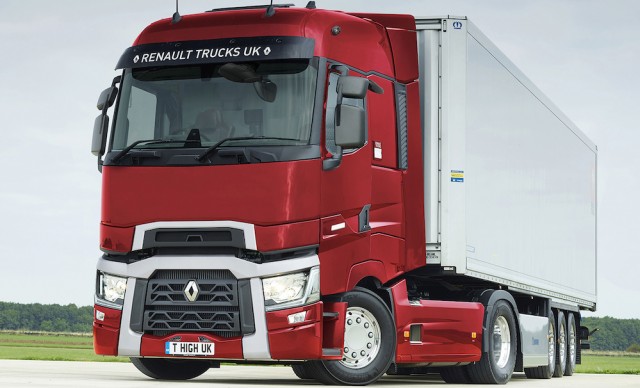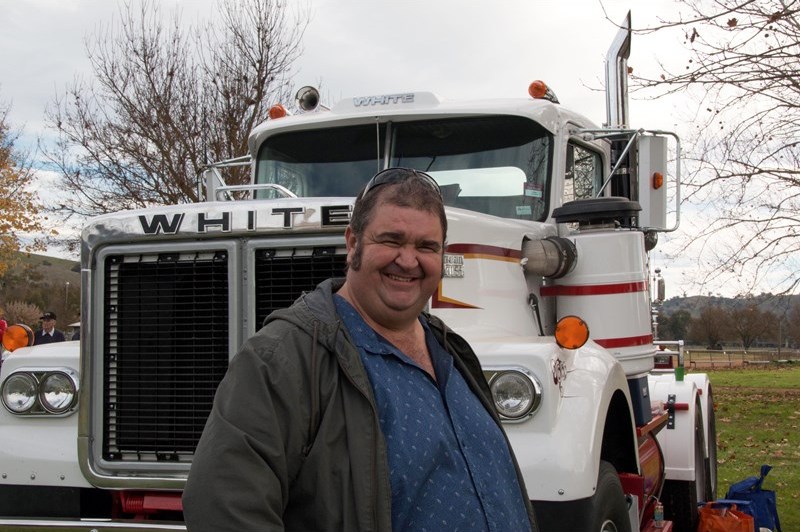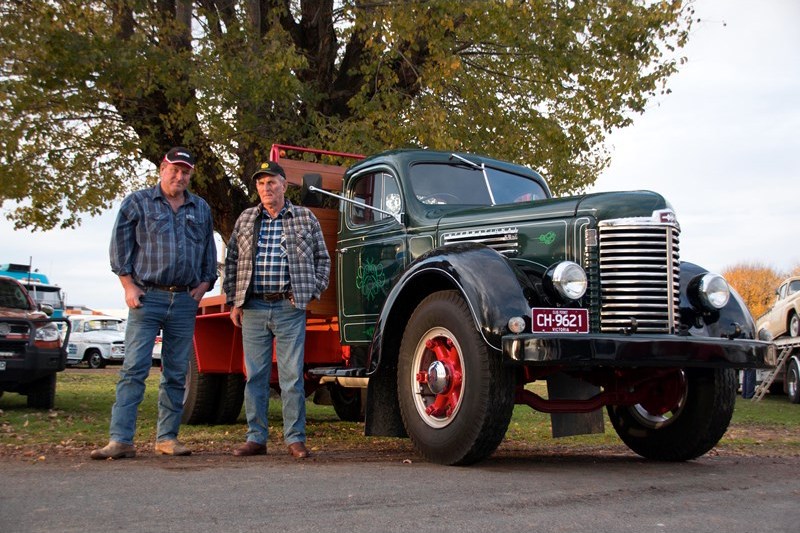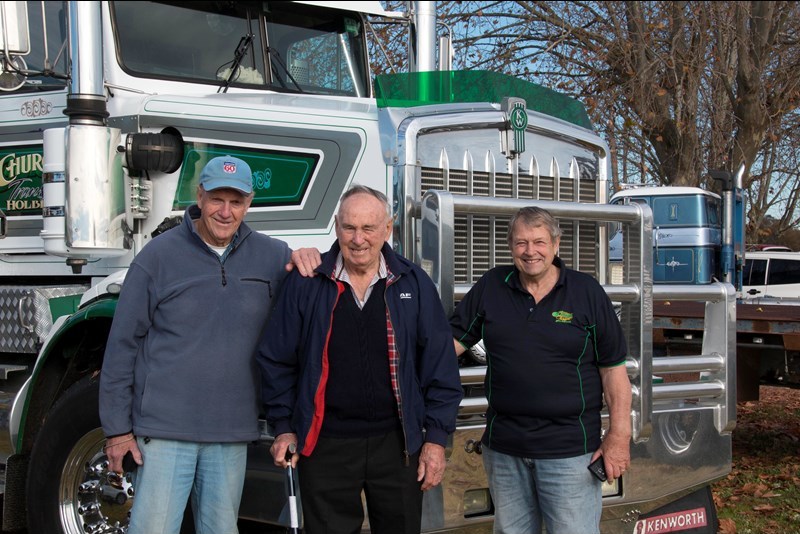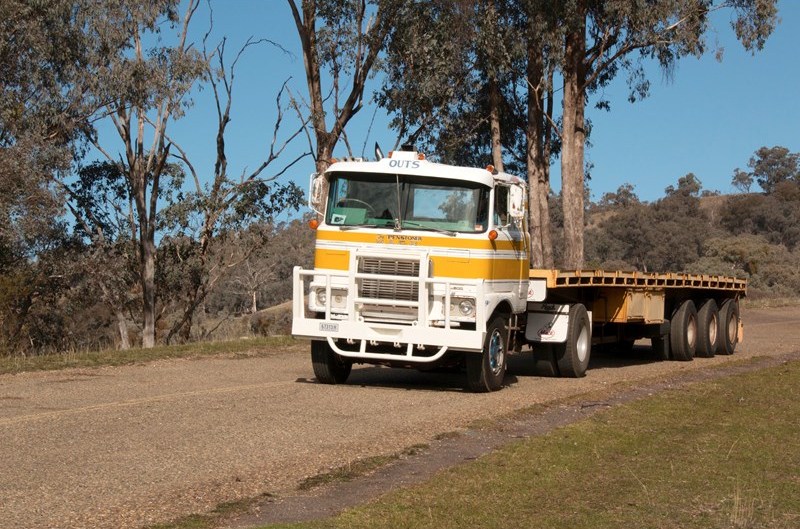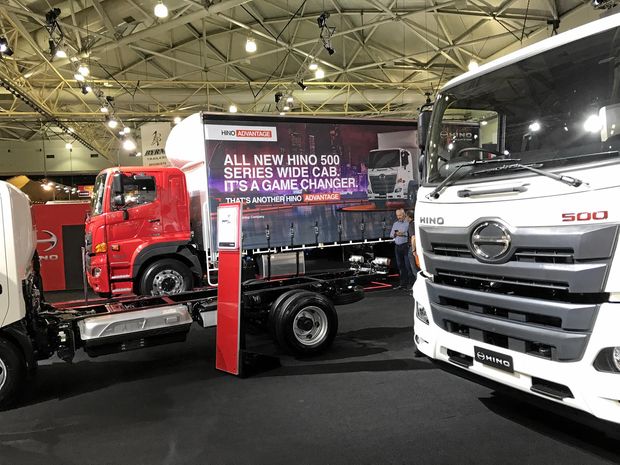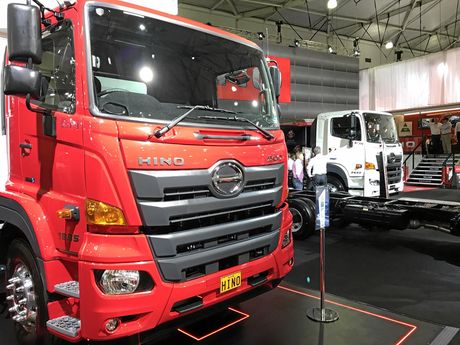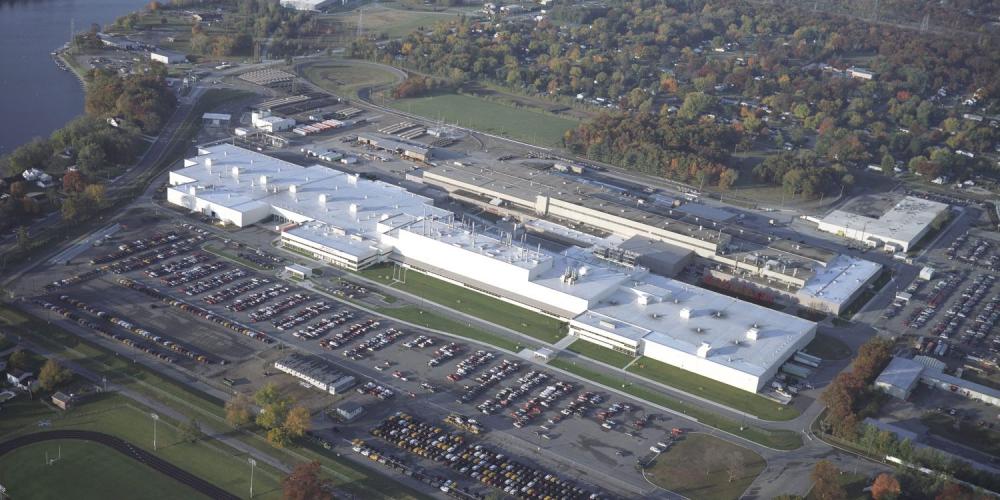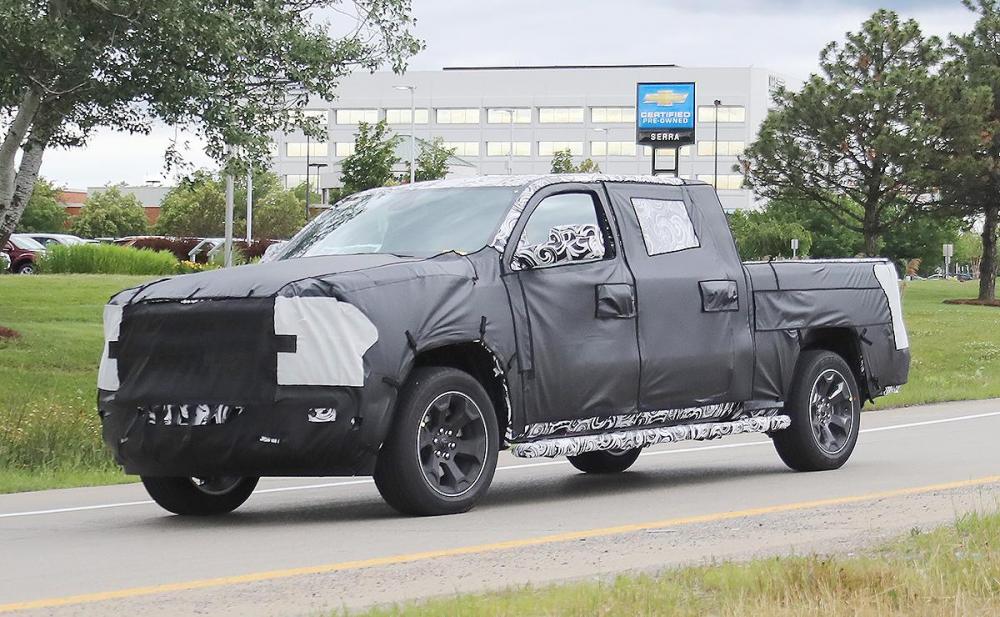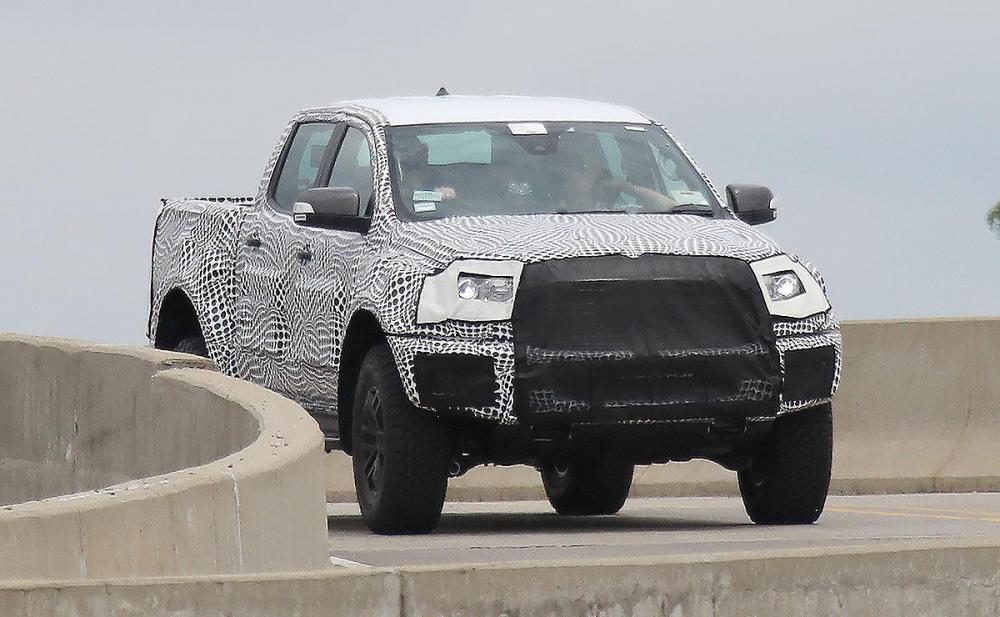
kscarbel2
Moderator-
Posts
17,893 -
Joined
-
Days Won
86
Content Type
Profiles
Forums
Gallery
Events
Blogs
BMT Wiki
Collections
Store
Everything posted by kscarbel2
-
Tom, when you called Watt's Mack (provider of the BMT website) at 1-888-304-6225 and asked about availability of the 6QD120 brake shoe wear plates, what did they say? If the good folks at Watts can't assist you, I believe PAI lists them. (The part number is 6QD120....without the "A". The "A" was for Mack internal use.)
-
Renault Trucks Press Release / June 22, 2017 In response to the changing UK and Irish markets, and a clear demand from customers, Renault Trucks is introducing a newly-engineered right-hand drive Range T High, available from early 2018. The flagship right hand drive Range T High with flat floor cab takes pride of place in the robust, efficient Renault Trucks line-up, driving new opportunities for the brand with long-haul operators and owner drivers. “For UK and Irish customers, while the standard Range T continues to deliver the best available total cost of ownership, we have listened and we recognise that more operators are looking for a more spacious and luxurious sleeper cab,” comments Nigel Butler Commercial Director, Renault Trucks UK. “Since launch in 2013, the left hand drive Range T High has been universally acclaimed in Europe and by operators and press alike here in the UK. Our flagship flat floor right hand drive models offer spacious, comfortable and well-appointed working and living areas that will appeal to both drivers and operators who specify vehicles that are a home-from home, and those who prioritise image.” Superior levels of performance and comfort have come together in Range T High and are reflected in the specification levels available of the three core variants. ‘International’, featuring fabric seats with rotating passenger seat, flat floor, standard bunk and steel wheels, is available in 440hp and 480hp in 6x2 configuration only. ‘Driver’ comes with full leather seats with rotating passenger seat, performance lower and ultimate upper bunk, deep fridge, compact dashboard, Alcoa alloy wheels, aluminium suzie support and additional catwalk, and is available in 440hp, 480hp and 520hp. The top of the range ‘Driver Lux’ - available in 480hp and 520hp - is to luxury specification and additionally includes backrest, lockers, luxury curtains, laminated side windows and aluminium air tanks. Nigel Butler continues: “Attracting and retaining good drivers is a real priority for operators facing the critical shortage of trained professionals in the industry. The generous working, living and sleeping environment of the right hand drive Range T High will help enhance driver satisfaction and productivity as the flat floor delivers the comfort levels needed for international or long distance transport.” Alongside the proud and professional image that the right hand drive Range T High projects on the road, Renault Trucks’ unwavering commitment to customer efficiency always comes first, as he explains: “In the UK, the Renault Trucks brand is growing, and our highly rated Euro-6 product range is considered a real alternative for customers. Efficiency and fuel economy remain strongpoints of the Range T High’s latest generation Step C 13-litre engine, while enhanced residual values support the Range T’s excellent total cost of ownership performance, ensuring the right hand drive flat floor cab makes commercial sense for long-haul operators.” To support the launch of the right hand drive Range T High, Renault Trucks UK is running a series of digital and social promotions which direct viewers to the Range T High website, www.range-t-high.co.uk where visitors can register interest in the new vehicle. .
-
Owner/Driver / June 23, 2017 The third Sylvia’s Gap Road Run raised funds for a permanent truck museum at Gundagai. Sylvia’s Gap was one of the most perilous stretches of the Hume Highway until the highway was diverted in 1983. Today this section of road near Tumblong, New South Wales, is on private property. But owners opened their gates on Sunday, June 11, for the Sylvia’s Gap Road Run. The event has been held annually since 2015 to raise money for the Australian Road Transport Heritage Centre (ARTHC) which plans to build a truck museum at Gundagai. This year 48 trucks took part, led by Churchill Transport’s 1990 Kenworth T650. John Scott, 75, was behind the wheel and Rex Shiel, 90, was in the passenger seat. The retired interstate truck drivers have known each other since the 1950s. The run reminded John of the old road’s dangers: "I can’t believe that the road was so small, so narrow, and so windy and steep." Motorbikes, utes, cars and ex-military vehicles followed the trucks on the run. The ARTHC’s fundraising weekend began with a truck show at the Gundagai Show Grounds on Saturday, June 10. Prizes were awarded to Leigh and Kerry Rankin of Katunga, Victoria, for their 1977 White Road Boss; and the Garner family of Tumut for their restored 1947 International KB7. On Saturday night 180 people attended a dinner where an auction raised $9,500. Barry Grimson, one of five instigators of the 1979 Razorback Blockade, was guest speaker. The ARTHC is already operating a truck museum from a temporary location at the corner of Tor Street and Jack Moses Avenue, Gundagai. It is open from 10am to 3pm from Thursdays to Sundays. Funds raised over the weekend will help build a larger permanent museum. Anyone wishing to become involved with the ARTHC or to donate funds should visit www.arthc.com.au or phone Daryl Weston on 0427 756 983 or Jim Morton on 0408 441 495. .
-
Hino wins at Bris truck show Big Rigs / June 27, 2017 This year has been a big one for Hino, with the release of the Wide Cab 500 series followed up by a win at the Brisbane Truck Show. In its first public outing, the Hino 500 Series Wide Cab won its first award, one judged by a panel of leading trucking journalists. Hino Motor Sales Australia chairman and CEO Steve Lotter said: "We are delighted and honoured to be recognised as the Best Light or Medium Duty Truck at the country's premier truck show. "The Hino 500 Series Wide Cab boasts the most comprehensive active safety package of any Japanese truck in the medium duty truck category including Vehicle Stability Control as standard - an Australian first for this class of Japanese built trucks. "As a result of customer feedback, we have expanded our transmission range offerings including three different six-speed automatic variants with fuel efficient Allison units with a push button shift selector.” All 500 Series Wide Cabs are supported by Hino Advantage, a suite of business building solutions and more than 60 dealerships and service centres across the country. Judging criteria at the show included technical innovation, safety and customer support measures such as the delivery time, distribution network and value for money. One of the judges said: "The Hino 500 Series Wide Cab has a strong package of vehicle safety and reduction in driver fatigue through the matching of attractive engine and automatic driveline options.” When talking about the Hino stand, Mr Lotter said the show was more than just an opportunity to demonstrate the depth of the company's range - it was also about the evolution of the brand and business. "Two years ago, we celebrated our 50th anniversary in Australia at the show. "This year's stand focused on our evolution as a trusted business partner that provides our customers with high quality products and business building solutions such as Hino Advantage - all of which were on display at the show.” A prototype of the new Hino 300 Series 4x4 - on display for the first time in the world (covered in the previous issue of Big Rigs) opening the off-road market for Hino, was one of the more popular attractions on the manufacturer's stand. .
-
Scania Group Press Release / June 21, 2017 By collaborating in sustainable transport and logistics solutions, HAVI and Scania are actively addressing global climate goals. Beginning quarter three, HAVI and Scania will start to implement a five year roadmap aimed at making a significant carbon footprint reduction in transport operations to and from McDonald’s restaurants in several European countries utilizing Scania’s Next Generation trucks and operating solutions. The aim is to significantly reduce diesel powered vehicles and shift approximately 70 percent of HAVI’s total truck fleet to alternative fuels, for example, gas and hybrid models, by 2021 within several European countries. The CO2 emissions in deliveries by HAVI to McDonald’s restaurants utilizing Scania’s next generation trucks and operating solutions will be continuously monitored in real time, bringing existing fleet connectivity to the next level. This significant transformation of the fleet is expected to lead to CO2 reductions ranging from 15 to 40 percent for every kilometre driven, depending on route, fuel and traffic conditions. “Innovation is absolutely critical to our sustainability journey and to use our scale for good. Our work with companies like HAVI and Scania takes a proactive approach to finding and implementing more sustainable supply chain solutions, and contributes to our global supply chain and sustainability strategy.” said Chris Yong, Global Logistics Director at McDonald’s. “Leaders in business have a responsibility to drive change. In this partnership we are setting a new standard for urban deliveries. We are not only discussing plans, but actually implementing measures here and now, to benefit the communities where we operate.” said Haluk Ilkdemirci, President, Logistics, HAVI. “Undeniably, we see demand for sustainable transport solutions growing. This is an example of the kind of smart partnerships through which we can be more innovative and together accelerate the shift towards a sustainable transport system. ” said Henrik Henriksson, President and CEO at Scania The gas- and hybrid trucks are designed to generate close to zero air pollution and significantly reduce carbon emissions in cities. The trucks are significantly quietier and along with the low-noise cooling equipment will help lower the impact of the deliveries made in city centres and elsewhere. Additionally, HAVI and Scania are developing a truck with special equipment to collect waste such as used cooking oil, plastic materials and cardboard from restaurants for recycling. This will help drive increased recycling while reducing the transport of normal waste collections, reducing unnecessary additional kilometres and therefore further reduce CO2 impact. Through this partnership HAVI and Scania are not only taking steps towards a sustainable future, but also taking action based on solutions and technologies that are available and ready to be implemented here and now for their customers, like McDonald’s. The collaboration will initially focus on Europe while similar approaches are also being explored for Asia. .
-
Particularly today, the automakers AND the government don't want you to retain a vehicle for 12 years. The automakers want to make money, and the government wants you driving ever cleaner vehicles. In recent years when I visit the US, I've noticed a higher percentage of older passenger cars, SUVs and light trucks on the roads. The golden era of the American dream has passed. The rise in cost-of-living has substantially exceeded wage growth for some time now. Many recall, as a child, when your father purchased a new vehicle every three years. And the mother didn't have to work, rather she could stay home and personally raise the children (which is why you turned out well). That child today, together with his wife working as well, has with their two salaries half or less the purchasing power that their parents had.
-
Heavy Duty Trucking / June 27, 2017 Kenworth and Peterbilt dealers will represent the brands at the inaugural North American Commercial Vehicle Show Sept. 25-28 at the Georgia World Congress Center in Atlanta. The two Paccar-owned brands were the only North American heavy truck makers not exhibiting at the new show, instead opting to exhibit at the Mid-America Trucking Show last March. “Kenworth and Peterbilt dealers understand that the NACV Show is the foremost North American gathering place for anyone involved in the business of commercial vehicles,” said Larry Turner, president and CEO of Hannover Fairs USA and co-organizer of the NACV Show. “Securing all the leading brands on the show floor to showcase their latest innovations reinforces our vision for this new and important industry event.” The NACV show will be open to the press only on Sept. 24 and is open to exhibitors and their guests starting Sept. 25. General admission opens Sept. 26 and runs through the end of the show. NACV is a new event being put on by North American Commercial Vehicle Show Partnership, owned half by Newcom USA, a subsidiary of Canada’s Newcom Business Media, and Hannover Fairs USA, a subsidiary of Germany-based Deutsche Messe, which plans and stages trade fairs around the globe, including the big IAA Commercial Vehicle Show in Hannover, Germany. “We expect North American fleet decision makers, leaders and influencers to convene at the show to not only learn about the newest and latest innovations from the leading manufacturers but to meet, network and conduct business onsite,” said Joe Glionna, president of Newcom and co-organizer of NACV. Fleet decision makers can register to attend the North American Commercial Vehicle Show 2017 at attendee registration. To view the entire trade show floor, visit NACV Show 2017 floorplan. A current list of exhibitors is located here.
-
UPS commits to aggressive goals for more alternative vehicles, fuel and renewable power by 2025 Green Car Congress / June 27, 2017 UPS announced new sustainability goals to add more alternative fuel and advanced technology vehicles to its fleet while increasing its reliance on renewable energy sources. The goals, available in the company’s 2016 Corporate Sustainability Report, support UPS’ commitment to reduce its absolute greenhouse gas (GHG) emissions from global ground operations 12% by 2025, a goal developed using a methodology approved by the Science Based Targets initiative. UPS has a goal that 25% of the electricity it consumes will come from renewable energy sources by 2025—a significant increase from the 0.2% in 2016. In addition, by 2020 UPS plans that one in four new vehicles purchased annually will be an alternative fuel or advanced technology vehicle, up from 16% in 2016. The company also set a new goal that by 2025, 40% of all ground fuel will be from sources other than conventional gasoline and diesel, an increase from 19.6% in 2016. Because of our size and scale, we know our commitments can shape markets, advance technologies and be a catalyst for infrastructure investments. We rely on the ingenuity of our employees, suppliers and technology partners to help us reach goals that will transform the shipping industry and spur innovation. —David Abney, UPS Chairman and CEO UPS operates more than 8,300 alternative fuel and advanced technology vehicles worldwide. The company’s fleet includes electric, hybrid electric, hydraulic hybrid, compressed natural gas (CNG), liquefied natural gas (LNG), propane and lightweight fuel-saving composite body vehicles. In addition to its use of alternative vehicles, UPS uses millions of gallons of lower-carbon footprint renewable diesel and renewable natural gas (RNG) in its fleet each year. These initiatives reinforce the company’s commitment to reducing its environmental impact despite growth in e-commerce deliveries, which are driving up energy used to operate facilities and power its vehicle fleet. The UPS vision entails a future smart logistics network of advanced technology vehicles and facilities powered by more diverse and sustainable energy sources, including on-site solar, off-site wind, renewable natural gas, renewable hydrogen, and renewable diesel delivered via advanced energy system infrastructure. UPS already deploys many of these technologies in its ground fleet and facilities, and plans to significantly increase their use in its worldwide fleet. Since 2009, UPS has invested more than $750 million in alternative fuel and advanced technology vehicles and fueling stations globally. The company used more than 97 million gallons of alternative and lower-carbon fuels in its ground fleet in 2016 and recently made an $18-million investment in on-site solar energy systems across eight facilities. UPS uses its Rolling Laboratory approach to determine which alternative fuels and technologies work best in each situation.
-
UPS Wants to Reduce Emissions by 12% in 8 Years Heavy Duty Trucking / June 27, 2017 UPS plans to reduce emissions from global ground operations 12% by 2025 as part of new sustainability goals, the delivery company said in its latest Corporate Sustainability Report. The company decided on its goal using a methodology approved by the Science Based Targets Initiative, a group that champions science-based sustainability efforts aimed at improving a company’s profitability and competitiveness. “Because of our size and scale, we know our commitments can shape markets, advance technologies, and be a catalyst for infrastructure investments,” said David Abney, UPS chairman and CEO. “We rely on the ingenuity of our employees, suppliers and technology partners to help us reach goals that will transform the shipping industry and spur innovation.” By 2020, the company plans to choose alternative fuel or advanced technology vehicles for one out of every four vehicles it purchases. That will help the company meet another goal to make 40% of all ground fuel used come from sources other than conventional gasoline or diesel by 2025, up from 19.6% in 2016. UPS has already launched several green initiatives and currently operates more than 8,300 alternative fuel and advanced technology vehicles globally. The company’s fleet uses a variety of vehicle types to achieve its green goals including, electric, hybrid electric, hydraulic hybrid, compressed natural gas, liquefied natural gas, propane, and lightweight composite body vehicles. Since 2009, UPS says that it has invested more than $750 million in alternative fuel and advanced technology vehicles and fueling stations globally. UPS also has a goal that 25% of the electricity it consumes will come from renewable energy sources by 2025, a significant increase from 0.2% in 2016.
-
Fleet Owner / June 27, 2017 United Parcel Service (UPS) is beefing up its “green vehicle” acquisition targets as part of its 2016 Corporate Sustainability Report; efforts aimed at reducing the company’s absolute global greenhouse gas (GHG) emissions from its ground operations some 12% percent by 2025. David Abney, chairman and CEO of UPS, noted in a statement that by 2020 one in four new vehicles purchased annually by Big Brown will be an alternative fuel or advanced technology vehicle, up from 16% in 2016. The company also set a new goal that, by 2025, 40% of all the ground fuel will be from sources other than conventional gasoline and diesel, an increase from 19.6% in 2016. UPS noted that it already operates more than 8,300 alternative fuel and advanced technology vehicles worldwide, which includes electric, hybrid electric, hydraulic hybrid, compressed natural gas (CNG), liquefied natural gas (LNG), propane, and lightweight fuel-saving composite body vehicles. Big Brown added that it also uses millions of gallons of lower-carbon footprint renewable diesel and renewable natural gas (RNG) in its fleet each year. Those savings come despite growth in e-commerce deliveries, which UPS said is driving up energy usage at its facilities and for powering its vehicle fleet. Since 2009, UPS noted that it has invested more than $750 million in alternative fuel and advanced technology vehicles and fueling stations globally, while using more than 97 million gallons of alternative and lower-carbon fuels in its ground fleet in 2016. The company added that it uses a “Rolling Laboratory” approach to determine which alternative fuels and technologies work best in each situation.
-
The 2017 Trans AM SE Bandit is very interesting. The limited production number is regrettable, given the vast sales potential.
-
FYI - The American Motors Corporation (AMC) - AM General connection https://en.wikipedia.org/wiki/AM_General AM General traces its roots to the Standard Wheel Company of Terre Haute, Indiana, which expanded in 1903 to include the Overland Automotive Division. In 1908, John North Willys purchased the Overland company, then based in Indianapolis, Indiana, and renamed it Willys-Overland Motors, Inc. In the 1940s, Willys-Overland developed a vehicle to U.S. Army's requirements and later mass-produced "America's first four-wheel drive one-fourth-ton tactical utility truck"—the Jeep of World War II fame. In 1953, Kaiser Motors purchased Willys-Overland, and changed the name to Kaiser-Willys Motor Company. In 1963 the company's name changed again to Kaiser-Jeep Corporation. In 1964, Kaiser-Jeep purchased the Studebaker facilities in South Bend, Indiana, and formed the Defense and Government Products Division in 1967, which after American Motors purchased Kaiser-Jeep became what is now AM General. AM General's roots (and its location in South Bend) also lie with the "General Products Division" of Studebaker, which, along with its substantial defense contracts, was acquired by Kaiser Industries in early 1964 after Studebaker closed its U.S. auto manufacturing operations. At the time, Kaiser had been awarded a US$87 million Army truck contract, and under government pressure agreed to perform the work at the South Bend plant it had recently acquired from Studebaker. Subsequently, American Motors Corporation (AMC) purchased the Jeep Corporation from Kaiser in 1970 when Kaiser itself decided to leave the auto business. In 1971, AMC made the General Products Division of Jeep (producing military trucks, as well as contract and non-commercial vehicles) a wholly owned subsidiary and renamed it AM General Corporation. AM General produced buses, large trucks, and Jeeps for industrial, military, and government use. In the late 1970s, it developed the High Mobility Multipurpose Wheeled Vehicle (HMMWV, nicknamed "Humvee") for military use as a heavy-duty replacement for the jeep. The vehicle later became available in a civilian version sold under the Hummer brand name. Another familiar product from the AM General line was the Jeep DJ-5 series—a purpose built "Dispatch Jeep" 2-wheel drive (RWD) version of the Jeep CJ-5—used in huge numbers as a right-hand drive mail delivery vehicle by the United States Postal Service. Production of buses lasted only from 1974 until 1979. American Motors ended its history as an independent automaker in 1982 when controlling interest in the company was purchased by France's Renault. U.S. government regulations at that time forbade ownership of defense contractors by foreign governments, and Renault was partially owned by the French government. Therefore, in 1983, AM General was sold by AMC to the LTV Corporation and it became a wholly owned subsidiary of the LTV Aerospace and Defense Company. (As a result, AM General remained an independent company after AMC was purchased by Chrysler Corporation.)
-
South Bend Tribune / June 23, 2017 Military truck producer AM General has agreed to sell its commercial assembly plant to SF Motors, a Chinese-owned electric vehicle company, in a move that will preserve more than 400 auto jobs in Mishawaka, the company announced Thursday. The sale, including the land, plant and certain manufacturing equipment, doesn’t include AM General’s military assembly plant, where it produces the High Mobility Multipurpose Wheeled Vehicle, or “Humvee,” for military-related business. SF Global will pay $110 million for the 700,000-square-foot plant, according to publicly available filings, and make $30 million in “key upgrades” to the facility, which sits between McKinley Highway and Jefferson Boulevard, west of Bittersweet Road. The sale, which is subject to U.S. and Chinese regulatory approvals, is expected to close later this year, preserving about 430 jobs in Mishawaka, including 368 union jobs. “We are confident that SF Motors is the right long-term owner to support the (plant), as well as the South Bend community and the State of Indiana,” Andy Hove, president and CEO of AM General, said in a statement Thursday. “This transaction puts the (plant) on solid ground to keep the assembly lines running,” Hove said, “providing our tremendously talented and dedicated employees new opportunities as part of SF Motors and its plans to produce next generation electric vehicles.” SF Motors is a subsidiary of Sokon Industry Group, a publicly-traded company listed on the Shanghai Stock Exchange that is principally engaged in the research, development, manufacture and sales of automobiles, engines and accessories. The company, based in Silicon Valley, Calif., will use the commercial assembly plant to produce “intelligent” electric vehicles, with materials sourced primarily from U.S. sources, after a one- to two-year period of retooling. AM General announced the sale to employees Thursday morning. “We didn’t expect it, but we knew the company was having a hard time locking in long-term work here,” said Don Brody, chair of UAW Local 5. “I think it will be a good thing in the long run.” “Off-hand, it’s good news,” said Joe Taylor, a state representative and president of the local union. “It’s retaining 400-plus jobs in this community.” AM General had planned mass layoffs at the plant beginning in October, when its sole remaining customer contract, with Mercedes-Benz for the R-Class, a luxury vehicle for the Chinese market, expires. It ceased production of the MV-1, a purpose-built wheelchair accessible vehicle sold by Mobility Ventures, a wholly owned subsidiary of AM General, at the plant last year. The future of that vehicle is not clear. In a statement, SF Motors said its position as a “US-based and American operated company headquartered in Silicon Valley, which respects and honors American rules and tradition. “The company, which will launch an American-made electric vehicle in the near future and will acquire an AM General facility, plans to keep the factory's existing 430 autoworker jobs with the goal of expanding operations in the future and creating even more positions,” the company said. It said it “hopes to become a leader in the new energy automotive space, and this acquisition and the surplus of talent that comes with it, will allow SF Motors to upgrade the commercial facility, enhance the local economy, and create a clean American-made electric vehicle.” As part of the deal, SF Motors has agreed to assume the current three-year contract with the union, Brody said, though it could be two years or more before the plant is ready for production. Until then, Brody said, “We’ll help employees the best we can to relocate and find different jobs.” Asked about working for a foreign boss, he said, “Basically, being a UAW member, we would like to have a U.S. manufacturer here, but they have accepted us as a union, and we are going to accept them as well.” He added, “I think it’s going to be a good thing in the end.” Fellow employee Kevin McClintock was more cautious in his assessment. "There's a lot of talk, a lot of talk, and it's all conjecture, all rumor,” McClintock said. "I don't know anything. I don't think anybody knows anything right now.” Asked about the prospect of assembling electric vehicles, McClintock said, “I don’t care what kind of car I’m making. I want steady work, and if this does that it will be great.” The sale brings to an unceremonious end to AM General’s 15-year foray into commercial vehicle production. The South Bend-based company originally built the $200 million plant for the H2, a civilian version of the Humvee sold by General Motors Corp, in 2002. The H3, produced in Louisiana, followed, but GM declared bankruptcy in 2009 and production of both models ended. Subsequent attempts to sell the brand, including to China-based Sichuan Tengzhong Heavy Industrial Machinery Co. and U.S.-based Raser Technologies, were not successful. This is not the first effort by a foreign company to build an electric vehicle here. Bright Automotive announced a deal to produce a plug-in hybrid van at the former H2 plant in 2011, but the Anderson, Ind.-based company could not secure funding for the project and closed. Think North America, meanwhile, briefly operated an assembly plant in Elkhart County, where it employed a few dozen people and produced several hundred two-seat electric vehicles before closing in 2012. The Norwegian-owned company had originally planned to hire 400 people and produce 2,500 vehicles at the plant annually. There was also a much ballyhooed, but ultimately short-lived, effort by Navistar Inc. in Wakarusa to manufacture electric delivery trucks. Then President Obama even visited the Navistar plant in August 2009 to help launch the project, which fizzled in 2013. That effort was spurred by a $39.2 million federal stimulus grant. .
-
Ram spy photos hint at longer wheelbase, split tailgate Automotive News / June 27, 2017 Spy photographers have caught the redesigned Ram 1500 during testing, and despite heavy camouflage some features of the truck are evident, including an apparent longer wheelbase and a new tailgate that folds down and splits in the middle to provide closer access to the bed. The next-generation light-duty pickup, which carries the DT body code, is to be revealed in January at the Detroit auto show. Fiat Chrysler will begin production of the truck that month at a retooled Sterling Heights, Mich., assembly plant. FCA will continue building the current version, the DS Ram 1500, at the nearby Warren Assembly plant in suburban Detroit while production of the DT version ramps up, supplier sources say. As Automotive News first reported in September, the next-generation Ram 1500 will continue to use steel for most of its body panels instead of switching to aluminum like the Ford F-150. The pickup's exterior styling will be largely evolutionary, keeping the accentuated raised hood and mammoth chrome grille, albeit in a slightly changed shape, according to sources. The headlights will shrink and be more integrated into the grille than those of the current generation, giving the vehicle's front fascia a toughened, squinty appearance. Under the hood, the new Ram 1500 is expected to get an upgraded 3.6-liter Pentastar engine with direct injection. A turbocharged inline-four will be optional, according to spy shots. FCA officials have said that the company plans to incorporate fuel-saving belt-start generators in its next-generation pickups to further improve fuel economy. But continuation of the Ram's 3.0-liter V-6 turbodiesel in the new generation depends on FCA working out legal concerns with federal regulators over alleged, undeclared engine control software discovered during testing. New technologies under the hood will require more air, forcing designers to include a new large air intake above the tow hooks on the front bumper. Horizontal fog lights integrated into the front bumper will largely mimic the styling of the headlights above, sources said. Staying with steel will allow the Ram to separate itself from competitors by using more complex shapes in its body panels. The pickup's side panels, for example, are said to feature a styling line -- front-to-rear including around the top of the wheel wells -- to evoke a more muscular stance. At the rear, the retooled Ram's taillights will be smaller, with backup lights integrated vertically nearer the tailgate, instead of their current location at the bottom of the taillights. Inside the cab, the biggest change is expected to come in a new, flattened center console layout that will allow for additional storage space, along with an infotainment system upgrade to the latest versions of FCA's Uconnect system, sources said. Photo gallery - http://www.autonews.com/apps/pbcs.dll/gallery?Site=CA&Date=20170626&Category=PHOTOS01&ArtNo=626009993&Ref=PH .
-
Ford hatching Ranger Raptor variant Automotive News / June 27, 2017 Ford Motor Co. is hatching plans for a Raptor performance variant of the forthcoming Ranger midsize pickup. Spy photos of a camouflaged Ranger on Ford's test track in Dearborn, Mich., show a more aggressive front end than what's shown in spy shots of the standard Ranger. The latest photos also show what appear to be large fender flares, a hallmark of the F-150 Raptor. It's unclear what engines the Ranger will feature, but they could include the 2.7-liter EcoBoost found in the F-150. The Ranger's engine is expected to be paired with Ford's new 10-speed transmission, which the automaker is rolling out across its lineup. Ford, in a statement, said it does not comment on future product or camouflaged vehicles in spy photos. In January at the Detroit auto show, the automaker announced plans to revive the Ranger, with production of the 2019 model beginning late next year at the Michigan Assembly Plant in Wayne, Mich. It will compete against the Chevrolet Colorado, GMC Canyon and Toyota Tacoma. Ford last sold the Ranger in the U.S. in 2012, but it continues to build and sell it globally. Photo gallery - http://www.autonews.com/apps/pbcs.dll/gallery?Site=CA&Date=20170626&Category=PHOTOS01&ArtNo=626009992&Ref=PH&Profile=1200 .
-
Volvo Trucks Press Release / June 26, 2017 Every year, according to the World Health Organization, more than 260,000 young people die in traffic accidents. Too many of these accidents involve trucks. In one year alone Volvo Trucks ‘Stop Look Wave’ campaign has taught over 100,000 children from around the world, to be safer around trucks and heavy traffic. Learn more: http://www.volvotrucks.com/stoplookwave .
-
The Flex is extremely popular in California.
-
Sold! GM offloads Opel onto PSA Peugeot Citroen
kscarbel2 replied to kscarbel2's topic in Odds and Ends
GM now expects $5.5B charge from its sale of Opel Reuters / June 27, 2017 DETROIT -- General Motors now expects the charge for its sale of Opel to PSA Group to reach $5.5 billion versus its previous estimate of $4.5 billion, due to additional costs associated with the deal, Chuck Stevens, GM's CFO, said on Monday. Opel said earlier this month that its sale to PSA could be completed as early as July 31, pending regulatory approval from antitrust authorities, after the companies initially said the transaction could be completed by year end. GM said in March that it would sell its chronic money-losing European operations of Germany's Opel and UK sister brand Vauxhall to PSA. Stevens also told analysts on a conference call that GM expects new vehicle sales in the U.S. to hit a seasonally adjusted annual rate of "low 17 million" units for 2017 and reiterated the company's target to bring U.S. inventories of its vehicles down to 70 days' supply by December from 110 days in June.
BigMackTrucks.com
BigMackTrucks.com is a support forum for antique, classic and modern Mack Trucks! The forum is owned and maintained by Watt's Truck Center, Inc. an independent, full service Mack dealer. The forums are not affiliated with Mack Trucks, Inc.
Our Vendors and Advertisers
Thank you for your support!


